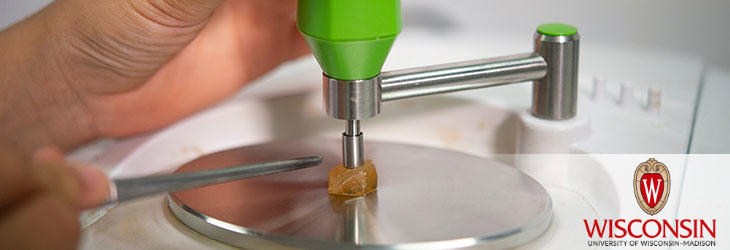Research Tools

Device That Uses Dielectrophoresis to Transport and Position Individual Particles/Cells for Analysis
WARF: P05149US
Inventors: Robert Hamers, Joseph Beck
The Wisconsin Alumni Research Foundation (WARF) is seeking commercial partners interested in developing a novel device that uses dielectrophoresis to gently transport and position particles, such as bacteria or nanoparticles, for individual analysis.
Overview
Dielectrophoresis is a technique for gathering particles that uses an electric field to induce an electrical polarization in an uncharged object. The electrical polarization then interacts with variations in the electric field, resulting in an attractive or repulsive force that drives collection of the particles.
Combining dielectrophoresis with electrical analysis has proven difficult. Traditionally, the efficient capture of particles has necessitated the use of relatively large (macroscopic) electrodes, damaging voltages or both. Large electrodes suffer from such poor sensitivity that these methods are inferior to existing particle analysis technologies. Damaging voltages not only complicate analysis, they cause poorly reversible particle binding.
Additionally, the particles cannot be positioned precisely into an electrode gap after they have been collected. The electrodes are too large and lack the sensitivity to transport single particles. And current techniques for releasing cells after they have been collected result in poor capture efficiency or use harsh cell removal techniques.
Combining dielectrophoresis with electrical analysis has proven difficult. Traditionally, the efficient capture of particles has necessitated the use of relatively large (macroscopic) electrodes, damaging voltages or both. Large electrodes suffer from such poor sensitivity that these methods are inferior to existing particle analysis technologies. Damaging voltages not only complicate analysis, they cause poorly reversible particle binding.
Additionally, the particles cannot be positioned precisely into an electrode gap after they have been collected. The electrodes are too large and lack the sensitivity to transport single particles. And current techniques for releasing cells after they have been collected result in poor capture efficiency or use harsh cell removal techniques.
The Invention
UW-Madison researchers have developed a novel device that uses dielectrophoresis to gently transport individual particles, such as bacteria or other cells, to a fixed point for electrical analysis. Particles are attracted to an electrode edge through dielectrophoresis. Next, a controllable fluid stream precisely transports individual particles along the electrode edge until they reach the desired position for electrical or other analysis. After analysis, the particles can be released at will.
By moving and focusing individual particles, this technology enables electronic “fingerprinting” of distinct cells, bacteria, nanoparticles or other particles. Every particle within a mixture can be analyzed and specific particles can be detected rapidly, making this inexpensive device potentially useful for quality control in nanomanufacturing, bioterrorism monitoring or monitoring of air and water pollution.
By moving and focusing individual particles, this technology enables electronic “fingerprinting” of distinct cells, bacteria, nanoparticles or other particles. Every particle within a mixture can be analyzed and specific particles can be detected rapidly, making this inexpensive device potentially useful for quality control in nanomanufacturing, bioterrorism monitoring or monitoring of air and water pollution.
Applications
- May enable label-free identification of individual biological cells
- May be used for quality control in nanomanufacturing
- May be used for analysis of water or air pollution
- Potentially useful for bioterrorism monitoring
Key Benefits
- Bacteria can be maintained in a live state throughout the capture, transport and release processes.
- Use of small electric potentials prevents damage to captured particles and permits their efficient capture and release.
- Highly sensitive—may be capable of detecting as little as one particle in a liter of fluid
- Individual nanoscale particles can be positioned precisely and analyzed.
- Does not require labeling of particles
- Uses robust, inexpensive components
- May be miniaturizable
Additional Information
For More Information About the Inventors
Publications
- Beck J.D., Shang L., Li B., Marcus M.S. and Hamers R.J. 2008. Discrimination between Bacillus Species by Impedance Analysis of Individual Dielectrophoretically Positioned Spores. Anal. Chem. 80, 3757-3761.
- Beck J.D., Shang L., Marcus M.S. and Hamers R.J. 2005. Manipulation and Real-Time Electrical Detection of Individual Bacterial Cells at Electrode Junctions: a Model for Assembly of Nanoscale Biosystems. Nanolett. 5, 777-781.
Tech Fields
For current licensing status, please contact Jennifer Gottwald at [javascript protected email address] or 608-960-9854